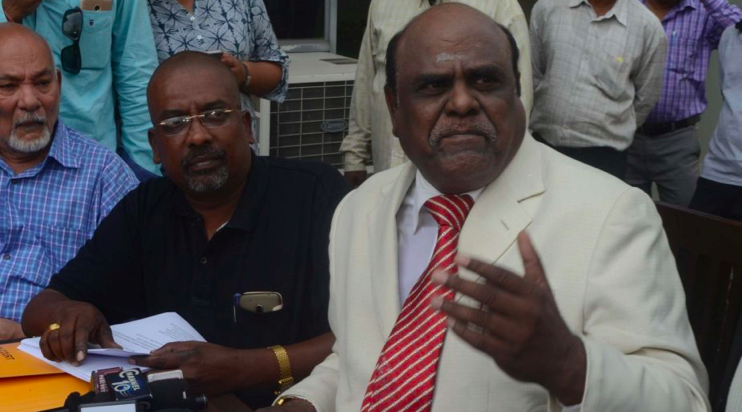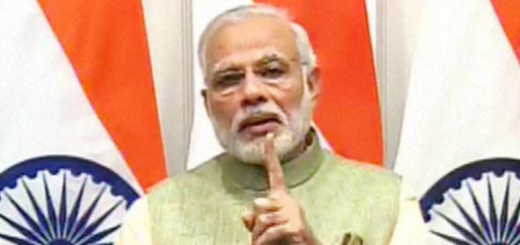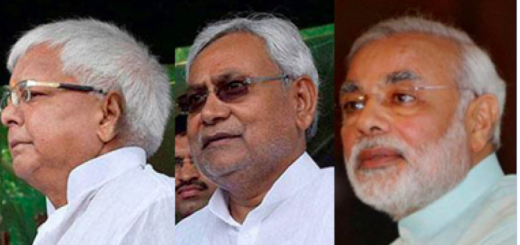Should anyone be punished without trial? L’Affaire Karnan

Sam Rajappa, in The Statesman, May 15, 2017
(Note: Reading through this article in the Statesman of Kolkotta by Sam Rajappa, Consulting  Editor of The Weekend Leader, and assuming that all the facts reported are correct, one wonders: “how can one have any faith in our Indian judicial system?”
Editor of The Weekend Leader, and assuming that all the facts reported are correct, one wonders: “how can one have any faith in our Indian judicial system?”
It is not the first time that we read that many High Court judges are corrupt. Shanthi Bhushan and his son Prasant Bhushan are well-known advocates who take up public litigation cases for the sake of common good and not for a pay. As reported at the tail end of this article Shanthi Bhushan who was Union Law Minister in Morarji Desai government had alleged that some Supreme court judges were corrupt, but no action was taken against him.
In the case of Justice Karnan, a Dalit, action is taken instantly without any court trial to prove him guilty. We don’t need a Solomon to see the double standards followed in these two instances and say for certain that one of these actions by the honourable judges was definitely wrong.
Here we are simply driven to despair and exclaim the biblical axim: “Who will guard the guards themselves?” (Qui custodiet ipsos custodies?) and “Doctor, heal yourself first.” A bald head prescribing medicine for baldness will only be ridiculed by the public and not taken seriously.
The article is full of instances that challenge elementary rules of rhyme and reason. This is so common in our political sphere where one thing is preached and the opposite practiced. Should it be the case in meeting out justice without fear or favour? We request our readers to send in your comments and suggestions to remedy the system, james kottoor, editor)
An idle mind, it is said, is the devil’s workshop. Justice CS Karnan, a Judge of the Madras High Court, was transferred to the Calcutta High Court as punishment for his unconventional behaviour and kept idle without any judicial work.
As such, he posed no threat to administration of justice. Instead of letting him complete the remaining one month of his term as Judge of the High Court and retire, a hurriedly constituted seven-member Constitution Bench of the Supreme Court has stirred a hornet’s nest by convicting him of contempt of court without a trial and sentenced him to six months of imprisonment.
The Bench observed, “We are of the unanimous view that Justice CS Karnan committed contempt of court … If we do not send him to jail, there will be a blemish that the Supreme Court has condoned the contempt committed by a judge” and thereby set a dangerous precedent of removing inconvenient judges. The Bench ruled, “Since the incident of contempt includes public statements and publication of orders made by the contemnor, which were highlighted by the electronic and print media, we are of the view that no further statements made by him should be published hereafter.”
Section 13 of the Contempt of Court Act says, “Notwithstanding anything contained in any law for the time being in force, no court shall impose a sentence under this Act for a contempt of court unless it is satisfied that the contempt is of such nature that it substantially interferes, or tends to substantially interfere with the due course of justice.” The gag order reminds the media of the dark days beginning 25 June 1975 when Prime Minister Indira Gandhi imposed Press censorship.
Justice Karnan’s lawyer, Mathew Nadumpara, wanted to move a petition in the Supreme Court seeking suspension of the six-month jail sentence, but was unable to get authorisation for filing the petition from any advocate-on-record. Nedumpara told Chief Justice of India JS Khehar that he was unable to file the writ petition under Article 32 of the Constitution challenging the contempt proceedings and the jail sentence of Karnan in the Supreme Court Registry, but not a single advocate-on-record wanted to get involved. “My Lord, all are afraid of you,” Nedumpara said. Cases in the Supreme Court can be filed only through an advocate-on-record. Counsel for Karnan contended that the petitioner is a judge of the Calcutta High Court which is not under any disciplinary jurisdiction of either the CJI or the seven-judge Bench constituted by the CJI in this case.
The Contempt of Courts Act was a cathartic jurisprudence which belonged to the Dark Ages, the era of inquisition and torture, distinct from the classical Roman law which constitutes the foundation of modern jurisprudence. The CJI refused to receive Karnan’s petition and asked Nedumpara to approach the Registry. Under Article 20 (2) of the Constitution, “No person shall be prosecuted and punished for the same offence more than once. The Supreme Court had already punished Justice Karnan twice: first on 8 February by issuing a notice directing him to refrain from handling any judicial or administrative work and on 1 May restrained all courts, tribunals, commissions or authorities from taking cognizance of any orders passed by him (Karnan) after 8 February.
On 9 May, the Supreme Court created history by convicting and sentencing a fellow judge for the first time since independence, and that too without a trial. The following day he left Kolkata for Chennai and held a press conference at the Chepauk government guest house. Meanwhile, a crack West Bengal police team led by DGP Surajit Kar Purkayastha and ADGP (Armed Reserve) Ranvir Kumar landed in Chennai and held consultations with the Tamil Nadu DGP TK Rajendran and Chennai Police Commissioner Karan Singa.
Joined by another police team from neighbouring Andhra Pradesh, a hunt was launched to secure the arrest of unarmed Justice Karnan, a sitting judge of the Calcutta High Court. It strains one’s credulity that such a high powered police force from three states could not track down Karnan in Chennai within a matter of hours while his lawyer had no difficulty visiting the ‘fugitive’ in the city to obtain his signature on the vakalatnama before a notary public to file a petition in the Supreme Court. On day one the Bengal team visited Srikalahasti, a pilgrim centre in Andhra Pradesh, and returned with divine blessings, while another team went to Tada on the Andhra-Tamil Nadu border made into a popular picnic spot because of the ample liquor shops that came up during the brief period the late MG Ramachandran experimented with total prohibition in Tamil Nadu.
On the same day Karnan was sentenced, a two-judge Bench of the Supreme Court held another person, liquor baron Vijay Mallya, guilty of contempt of court, but the proceedings before the Bench of Justices AK Goel and UU Lalit did not receive the publicity Justice Karnan got. Unlike the larger Bench headed by the CJI which dispensed instant punishment to Justice Karnan, the smaller Bench gave Mallya ample time to appear in person in court on 10 July and make his submissions before pronouncing any punishment. The incongruity of the differential treatment might have escaped the notice of their Lordships, but not Justice Karnan for whom it is yet another instance of humiliation heaped on him for being a Dalit.
Born in a humble Dalit family in a remote village in Cuddalore district of Tamil Nadu, Karnan’s father was a school headmaster. On his own admission, Karnan failed in the sixth and eighth standards, PUC, BSc and BL examinations. Nevertheless, he completed his bachelor in law degree from Madras Law College in 1983 and got himself enrolled as an advocate the same year.
By 2001, he became a booth-level election agent of the AIADMK which put his career on a rapid growth path. In September 2008, he found himself among 14 selected by the Madras High Court collegium comprising Chief Justice AK Ganguly and Justices PR Mishra and SJ Mukhopadhaya. Before the 14 names reached the Supreme Court collegium headed by CJI KG Balakrishnan, Justice Sathasivam wrote a letter of recommendation saying Karnan belonged to the Dalit community and was well versed in all branches of law. Justice Markandey Katju endorsed all the 14 names to be appointed as judges of the Madras High Court. This is how the collegiums system works.
There is no doubt the behaviour of Justice Karnan was not in keeping with the dignity of the higher judiciary. As Judge of the Madras High Court, he had passed strictures against the Chief Justice. When he was transferred to the Calcutta High Court, he issued an order staying his own transfer.
If the Supreme Court had any doubt about Justice Karnan’s mental health, its 9 May order needs re-examination. Apparently, what irked the Honourable Supreme Court was Justice Karnan’s 23 January letter to the CJI with copies to the President of India and the Prime Minister, leveling serious charges of corruption against fellow judges, including a few from the Supreme Court, and seeking an inquiry into them.
It may be recalled that Shanthi Bhushan, Union Law Minister in the government of Morarji Desai, also leveled similar charges against a few Supreme Court judges. No action was taken against him. Justice Karnan named the corrupt judges in the flock and offered to prove his allegations. He even challenged them to prove him wrong.
The named persons in the higher judiciary could have sued Justice Karnan for civil and criminal defamation. But none took up the challenge. Instead, the CJI took up the cudgels and landed Justice Karnan in his current predicament. He is determined to fight it out. The Supreme Court instead of following the procedure laid down in Article 124 (4) of the Constitution to remove an errant judge, as it did in the case of Soumitra Sen of the Calcutta High Court, took upon itself to punish Justice Karnan. The soap opera continues.

















I am sorry that our judiciary is becoming weaker and ineffective day by day. What is more depressing is that almost all officers who come from the so called lower castes do not get what is due to them from their own colleagues, speriors or subordinates. Every citizen knows what horrific sufferings fall on people belonging to the scheduled or backward classes. The irony is that innumerable NGOs, phillanthrophic socieies, and religious groups claim to stand by the downtrodden. What are they actually doing?